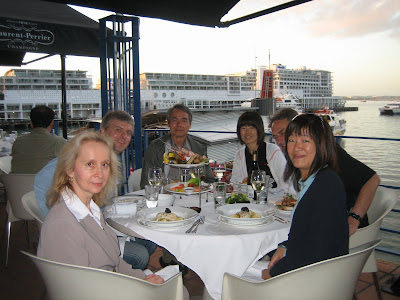 I returned from Northwestern University early this morning after a landing on a delayed United flight from Chicago O'Hare to Bradley airport in Hartford/Springfield that was preceded by an announcement by the pilot that we will be experiencing "extreme turbulence." My trip began about 5:30AM Thursday morning when I was picked up by a van service in Amherst only to have the shuttle to which the other passengers and I were to then be moved to get a flat tire right in front of Mount Holyoke College in the dark of night. Luckily, our shuttle was still in good condition so we did a swap and arrived at the airport in time for our flights. Travel is never dull and especially in the midst of a frigid winter.
I returned from Northwestern University early this morning after a landing on a delayed United flight from Chicago O'Hare to Bradley airport in Hartford/Springfield that was preceded by an announcement by the pilot that we will be experiencing "extreme turbulence." My trip began about 5:30AM Thursday morning when I was picked up by a van service in Amherst only to have the shuttle to which the other passengers and I were to then be moved to get a flat tire right in front of Mount Holyoke College in the dark of night. Luckily, our shuttle was still in good condition so we did a swap and arrived at the airport in time for our flights. Travel is never dull and especially in the midst of a frigid winter.My destination was Northwestern University, where its Transportation Center, directed by Professor Hani S. Mahmassani, was hosting a Symposium on Transportation Network Design and Economics. The symposium was to mark the visit of Professor Martin Beckmann (who was on my doctoral committee at Brown University) and the complete symposium agenda can be found here.
The symposium was outstanding and brought together researchers in engineering, economics, operations research, regional science, and even physics. I especially appreciated the attention to detail in the organization of this symposium with sufficient time scheduled for many exciting discussions, wonderful coffee breaks, and a delicious free lunch. Professor Beckmann had arrived on Wednesday having traveled first from Providence to NYC, where he saw an opera and visited museums. He had taken an Amtrak sleeper car from NYC to Chicago (he believes in experiencing many different modes of transportation) and told us that the service was great but his sleeping compartment was rather cold. He is traveling back to Providence also on Amtrak (but through Washington DC).
Professors Mahmassani and David E. Boyce are to be congratulated as well as the staff of the Transportation Center at Northwestern for organizing an exceptional venue and very stimulating symposium program! The discussions that took place germinated numerous research questions and ideas on a topic of great relevance regionally, nationally, and globally. The audience included faculty, students, and practitioners. There were participants from Northwestern University, the University of Illinois at Urbana, the University of Illinois at Chicago, Purdue University, Roosevelt University, Loyola University, and UMass Amherst, as well as individuals from the Chicago Transportation Authority, Cambridge Systematics, the Chicago Metropolitan Agency for Planning, and several independent consultants.
The symposium was a perfect way in which to honor the lasting contributions of Professor Martin Beckmann to the economics and science of transportation networks! It was thrilling to, once again, see Professor Beckmann, who is 85 years old, and whose wit and brilliance still astound.
The photo above of Professor Beckmann with me was taken at the lovely dining hall at the Allen Center at the Kellogg School at Northwestern University on January 28, 2010.




































